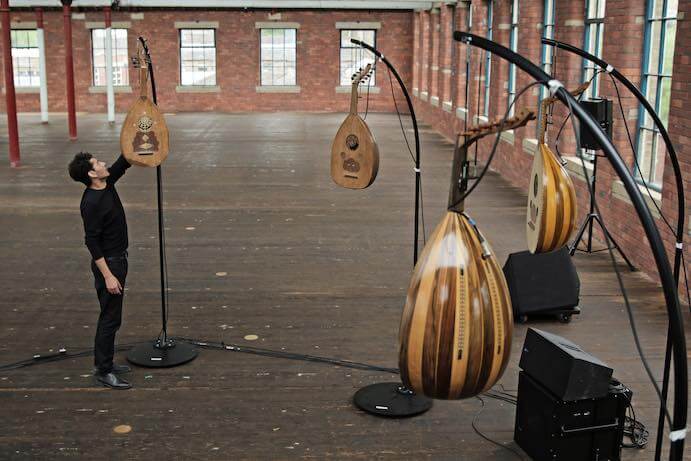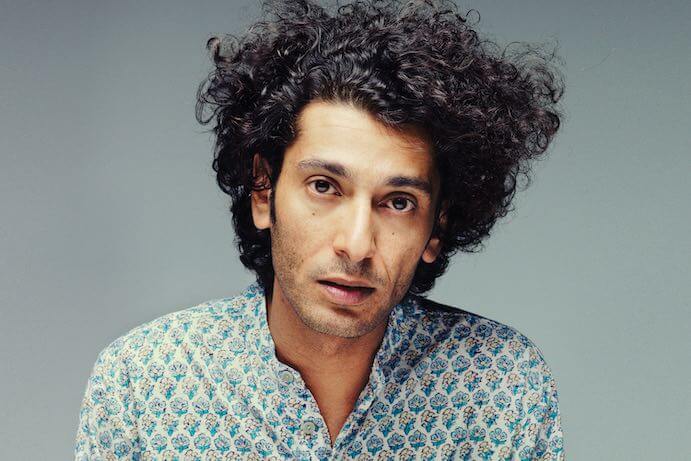Working at the intersection of electroacoustic composition and Arabic microtonality, London-based composer, oud-player, academic, and label founder Khyam Allami is reimagining the context of the contemporary oud.
Allami’s ongoing research project Kawalees is a multipart work for western and-nonwestern instruments that explores the application and manipulation of microtonality and gesture, intensified through live digital processing. In a recent commission by Opera North for the 2019 PRS New Music Biennial, Allami premiered Requiem for the 21st Century, an instillation in which microtonal performances by Allami and Opera North orchestra members are manipulated and played back through the bodies of several decaying ouds. In contemplation of the present, the aesthetics of Allami’s work makes reference to the myths and histories of the oud in commemoration of death.
We asked Khyam Allami five questions about his recent projects and evolving practice.
How does your ongoing research project, Kawalees, reimagine the established practice of Arabic microtonal systems?
It’s actually intrinsic to my relationship with the oud. About four years ago, after having played oud for around 10 years, I started to fall out of love with it. Sometimes I liken it to a relationship that had lost its fire. I started to privately experiment with different ways of approaching the instrument, but it always felt a little pastiche and cliché, like I was trying to impose something. I couldn’t find an approach that felt natural and progressive.
Then I asked myself: what are the oud’s fundamental characteristics? What makes it unique? And what are the fundamental musical principles that define Arabic and Middle Eastern music?
I realised that, aside from language and rhythmic cycles, the main defining feature of Arabic and Middle Eastern music is the maqām system: its tuning, and more specifically, all the variations in tuning that exist. When I managed to get my hands on an electroacoustic oud, I was able to explore all the subtleties of the instrument that are hard to reach acoustically. By finding new—and often very simple—sonic possibilities, I was able to break free from typical frameworks.
As those performance-based ideas started to develop, I turned to non-conventional melodic explorations of the maqām system. I worked with programmers Charles Matthews and John Eichenseer to develop a Max for Live patch called Comma to help me access microtonal tunings intuitively, in real-time, and use them with various digital sounds. After much ado, I settled on using a microtonally-tuned software piano with various midi processing effects. With that, I was able to develop very clear melodic, harmonic and time-based ideas that felt very personal and honest.
This exploration gave birth to the concept behind Kawalees, which is an Arabisation of the French word “coulisse” meaning the backstage area of a theatre, or various rooms and corridors around a principle space. In the context of this work, it refers to my searching within the Kawalees of the oud and the maqām system, but also my own Kawalees, the Kawalees of the mind.
I started exploring both avenues in tandem and very quickly realised that this would be a multi-part project; Part I (electroacoustic oud) and Part II (microtonal piano). One using the archetypal Arab instrument, and the other the archetypal Western instrument. Both modified through the use of technology, but through an approach that is heavily grounded in the performance of the maqāmāt (plural of maqām) and actually playing the instruments melodically.
In musical terms, my approach to Kawalees is based on exploring the maqāmāt as “states.” Rather than relying on typical micro-melodies or gestures, I started to think more about interval relationships and atypical phrasing, and how those can be expressed through the short notes of the oud, and the sustained resonances of a piano. This led to a lot of research around concepts of time—from fast inarticulate playing that sounds like a cassette tape being fast-forwarded, to long sustained notes that cluster around each other like timeless constellations.
I’m hoping for both parts to be released early 2020.

Khyam Allami performing Kawalees: Part II at CTM Festival, Berlin 2019–Photo courtesy Udo Siegfriedt/CTM Festival 2019
In terms of expression, in what ways does electroacoustic composition and digital processing extend the possibilities of the oud?
As versatile and rich as the oud may seem, acoustically it’s actually quite a limited instrument. It’s quieter than you’d expect, and the details get lost quickly unless you are performing in extremely controlled environments with excellent sound.
By using an electroacoustic oud, all the details are magnified, the dynamic range is far greater, and venue is not an issue. Add to this the ability to introduce digital processing, and suddenly, vast new worlds open up. But here lies the real difficulty: finding techniques and processes that don’t sound gimmicky, and the balance between relying on sound vs. relying on melodic performance.
Most of the musicians I’ve heard who use this electroacoustic instrument tend to treat it like an amplified oud and try to make it sound like an acoustic oud as much as possible. No matter how hard I tried, I couldn’t get it to sound as good as an acoustic instrument. The trick then, was to approach it as something else entirely. It had to stop being an oud, and instead be a new oud-based instrument.
By magnifying details that performers tend to avoid, I was able to reach a more vulnerable state of expression, something far more intimate. By using digital tools like ready-made Max for Live patches running in Ableton Live, I was able to challenge my own conceptions of taqsīm (instrumental maqām-based improvisation). I was then free to introduce sound as emotional content (rather than melody) to help explore subtler dimensions of the maqām system using a pallet that felt more representative of the current age—disruptions, regurgitations, loops, hard dynamic shifts, and sustained extensions of microtonal states.

Khyam Allami performing Kawalees: Part I at Sarāb, Wadi Rum 2019–Photo courtesy Mohammed Zakaria/Sarāb 2019
You designed a microtonal software patch to remodel Terry Riley’s In C. What new ways of listening does microtonality offer?
Actually, the patch, Comma, wasn’t designed specifically for In C. It was designed for Kawalees and as part of wider artistic research (which has become my PhD research topic). But, when Comma was ready, one of the first things I did was create a solo electronic version of Riley’s classic.
In the maqām system, the neutral third is a microtonal interval that lies between the major and minor third. The actual tuning of this interval changes from country to country and varies between approximately -30 cents and -45 cents from a 12-TET E natural. For me, it is the magic interval of middle eastern music, and this roughly 15-cent margin is what allows for such individuality in music making across North Africa, Middle East and Central Asia.
The opening interval of In C is a major third, so it was a no brainer to try performing the piece by re-tuning that major third to a neutral third—and changing the mode of the piece from C Major to the Arabic maqām Rast (which includes a replication of this neutral third between the fifth and seventh degrees). All these wonderful microtonal intervals locking, clashing, and swirling in space opened a totally new way to hear this piece and allowed for a new way of listening to a maqām by challenging hardened conceptions of harmony, repetition, form, and melodic development in Middle Eastern music.
For “Western” listeners, microtonality is often shrouded in esoteric language and mathematics, but in reality, it is something very natural and pure. By applying it to In C, the trance-inducing power of the piece is enhanced, and the way it feels is just beautiful—warmer, richer, more engulfing.
For “Middle-Eastern” listeners, maqām can feel quite monotonous and at times very monologous (a bastard word meaning something performed as a monologue). Hearing maqām Rast so abstracted and totally reliant on multiple instruments really helps refresh the ears and shine a light towards all the unexplored areas of this fascinating musical system.
In relation to Requiem for the 21st Century, how do you see the role of contemporary musical practice in creating transformative and self-reflective experience?
Big question! Those kinds of experiences have long existed in music. In a way, contemporary practices are just a means to reformulate methods for creating those kinds of experiences in ways that are relevant to our current age—whether that be artistic, or in reaction to technological, philosophical, political, or any other kind of change, development or events.
What’s most important to me is “what” I’m trying to say, and not necessarily “how” I’m trying to say it, which is a little contrary to how contemporary practices are usually considered—they are usually more about the process than outcome.
Novelty is alluring, but I think the most valuable initial reaction any work of art can activate is feeling—rather than thinking or discourse. A constant that I have found in the great artists I admire is their mastery of making you feel something immediately before you have a chance to analyse. When you do analyse, rationalise, philosophise, etc., you delve deeper and are left in awe of the complexities, but the initial reaction captures the imagination and leads you to further questioning.
Over time, I’ve come to realise that the only way to be successful in that is to be as honest and true to oneself and one’s ideas as possible. Once you are able to capture the feeling that the idea is dictating within you, then it’s just about finding the right means to that end—whether that be complex computer programming, mathematical compositional techniques, or just a single sustained note played very gently. It’s all about finding the right tools.

Khyam Allami Requiem for the 21st Century-Photo courtesy Rowland Thomas/Opera North 2019
What makes your label, Nawa Recordings, necessary in the context of our present time?
The Arab world is full of truly inspiring creative beings, many of whom are challenging all kinds of perceptions and concepts. Being able to offer a home for those musical explorations that is respectful to the art, the artist, and the audience is extremely dear to me—even if very time consuming and sometimes outright draining. That’s without even considering the financial realities.
How necessary it is, is not really for me to say. I personally feel that there are many other things that are far more necessary: developing educational practices and resources, creating new systems for artists rights and renumeration, opening dedicated venues and spaces. But I can only do what is within my means, and for now, that is Nawa.
Sometimes, I want to open up the label to all kinds of other artists from the Arab world working in established genres, but at the same time, I think Nawa’s focus on contemporary and alternative Arabic music—that has a very defined musical-cultural identity which challenges Arabic musical concepts—is closer to my heart. That’s what keeps me going, because it’s a personal and long-term investment.






















